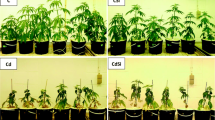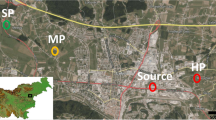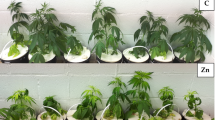Abstract
Experiments in semi-natural conditions were undertaken to assess hemp metal tolerance and its ability to accumulate cadmium, nickel and chromium. Cannabis sativa was grown in two soils, S1 and S2, containing 27, 74, 126 and 82, 115, 139 μg g−1 of Cd, Ni and Cr, respectively. After two months from germination and at ripeness, no significant alteration in plant growth or morphology was detected. On the contrary, a high hemp reactivity to heavy metal stress with an increase in phytochelatin and DNA content was observed during development, suggesting the Cannabis sativa ability to avoid cell damage by activating different molecular mechanisms. Metals were preferentially accumulated in the roots and only partially translocated to the above-ground tissues. The mean shoot Cd content was 14 and 66 μg g−1 for S1 and S2 soil, respectively. Although not negligible concentrations they were about 100 times lower than those calculated for the hyperaccumulator Thlaspi caerulescens. Similarly Ni uptake was limited if compared with that of the Ni-hyperaccumulator Alyssum murale. Chromium uptake was negligible. As expected on the base of the metal concentration detected in ripe plants, no statistically significant variation in soil metal content was detected after one crop of hemp. Nevertheless, a consistent amount (g) of Cd and Ni is expected to be extracted by 1 ha biomass of hemp (about 10 t) per year and along the time a slow restoration of deeper soil portions can be obtained by its wide root system (at least 0,5 m deep). In addition, the possibilities of growing hemp easily in different climates and using its biomass in non-food industries can make heavy metal contaminated soils productive. This means economical advantage along with a better quality of soil.
Similar content being viewed by others
References
Baker A J M, Reeves R D and Hajar A M 1994 Heavy metal accumulation and tolerance in British populations of the metallophyte Thlaspi caerulescens J. And C. Presl (Brassicaceae). New Phytol. 127, 61–68.
Brooks R R, Chambers M F, Nicks L J and Robinson B H 1998 Phytomining. Trends Plant Sci. 3(9), 359–362.
Cappelletto P, Brizzi M, Mongardini F, Barberi B, Sannibale M, Nenci G, Poli M, Corsi G, Grassi G and Pasini P 2001 Italy-grown hemp. Yeld, composition and cannabinoid content. Industrial Crops and Products 13(2), 101–113.
Cavallini A and Natali L 1991 Intraspecific variation of nuclear DNA content in plant species. Caryologia 44(1), 93–107.
Chaney R L, Malik M, Li Y M, Brown S L, Brewer E P, Angle J S and Baker A J 1997 Phytoremediation of soil metals. Current Opinion in Biotechnology 8(3), 279–284.
Correia F, Roy D N and Goel K 1998 Pulping of canadian industrial hemp (Cannabis sativa L.) presents some finding of using nonwood sources. Pulp & Paper-Canada 99(9), 39–41.
Cromack H T H 1998 The effect of cultivar and seed density on the production and fibre content of Cannabis sativa in southern England. Industrial Crops and Products 7(2–3), 205-210.
Charkowski E 1998 Hemp ‘eats’ Chernobyl waste. In Central Oregon Green Pages, website: www. empirenet.net/empnet/centrorg.htm.
Cunningham S D, Berti W R and Huang J W1995 Phytoremediation of contaminated soils. Trends Biotech. 13, 393–397.
Garbisu C and Alkorta I 2001 Phytoextraction: A cost-effective plant-based technology for the removal of metals from the environment. Biores. Technol. 77(3), 229–236.
Gupta M and Devi S 1995 Uptake and toxicity of cadmium in aquatic ferns. J. Env. Biol. 16(2), 131–136.
Howden R, Andersen C R, Goldsbrough P B and Cobbett C S 1995a A cadmium-sensitive, glutathione-deficient mutant of Arabidopsis thaliana. Plant Physiol. 107, 1067–1073.
Howden R, Goldsbrough P B, Andersen C R and Cobbett C S 1995b Cadmium-sensitive, cad1 mutants of Arabidopsis thaliana are phytochelatin deficient. Plant Physiol. 107, 1059–1066.
Khan A G 2001 Relationships between chromium biomagnification ratio, accumulation factor, and mycorrhizae in plants growing on tannery effluent-polluted soil. Environ. Int. 26, 417–423.
Khan A G, Kuek C, Chaudhry T M, Khoo C S and Hayes W J 2000 Role of plants, mycorrhizae and phytochelators in heavy metal contaminated land remediation. Chemosphere 41, 197–207.
Klapheck S, Schlunz S and Bergmann L 1995 Synthesis of phytochelatins and Homo-phytochelatins in Pisum sativum L. Plant Physiol. 107, 515–521.
Meagher R B 2000 Phytoremediation of toxic elemental and organic pollutants. Curr. Opin. Plant Biol. 3(2), 153–162.
Mediavilla V, Leupin M and Keller A 2001 Influence of the growth stage of industrial hemp on the yeld formation in relation to certain fibre quality traits. Industrial Crops and Products 13(1), 49–56.
Nedelkoska T V and Doran P M 2000 Characteristics of heavy metal uptake by plant species with potential for phytoremediation and phytomining. Minerals Eng. 13(5), 549–561.
Robinson B H, Leblanc M, Petit D, Brooks R R, Kirkman J H and Gregg P E H 1998 The potential of Thlaspi caerulescens for phytoremediation of contaminated soils. Plant Soil 203, 47–56.
Salt D E, Blaylock M, Kumar P B A N, Dushenkov V, Ensley B D, Chet I and Raskin I 1995 Phytoremediation: A novel strategy for the removal of toxic metals from the environment using plants. Bio/Technology 13, 468–474.
Salt D E, Smith R D and Raskin I 1998 Phytoremediation. Annu. Rev. Plant Physiol. Plant Mol. Biol. 49, 643–668.
Shallari S, Schwartz C, Hasko A and Morel J L 1998 Heavy metals in soils and plants of serpentine and industrial sites of Albania. Sci. Tot. Env. 209, 133–142.
Struik P C, Amaducci S, Bullard M J, Stutterheim N C, Venturi G and Cromack H T H 2000 Agronomy of fibre hemp (Cannabis sativa L.) in Europe. Industrial Crop and Products 11(2–3), 107-118.
Tyler G and Olsson T 2001 Plant uptake of major and minor mineral elements as influenced by soil acidity and liming. Plant Soil 230(2), 307–321.
Van der Lelie D, Schwitzguebel J P, Glass D J, Vangronsveld J and Baker A 2001 Assessing phytoremediation's progress in the United States and Europe. Environ. Sci. Technol. 35(21), 446A-452A.
Watanabe M E 1997 Phytoremediation on the brink of commercialization. Environ. Sci. Technol. 31, 182–186.
Zenk M H 1996 Heavy metal detoxification in higher plants-a review. Gene 179, 21–30.
Zhu Y L, Pilon-Smits E A H, Jouanin L and Terry N 1999 Overexpression of glutathione synthetase in indian mustard enhances cadmium accumulation and tolerance. Plant Physiol. 119, 73–80.
Author information
Authors and Affiliations
Corresponding author
Rights and permissions
About this article
Cite this article
Citterio, S., Santagostino, A., Fumagalli, P. et al. Heavy metal tolerance and accumulation of Cd, Cr and Ni by Cannabis sativa L.. Plant and Soil 256, 243–252 (2003). https://doi.org/10.1023/A:1026113905129
Issue Date:
DOI: https://doi.org/10.1023/A:1026113905129




